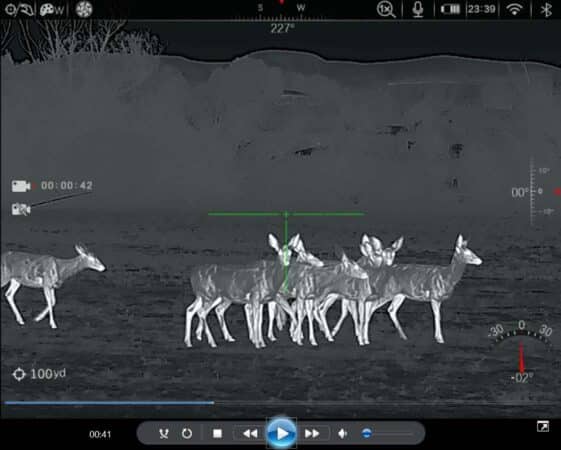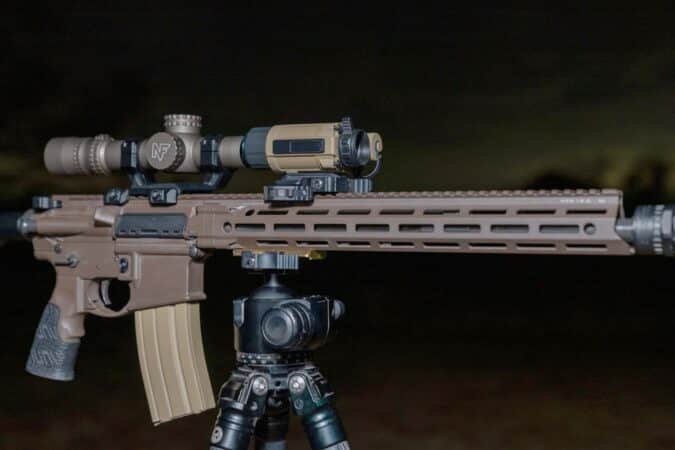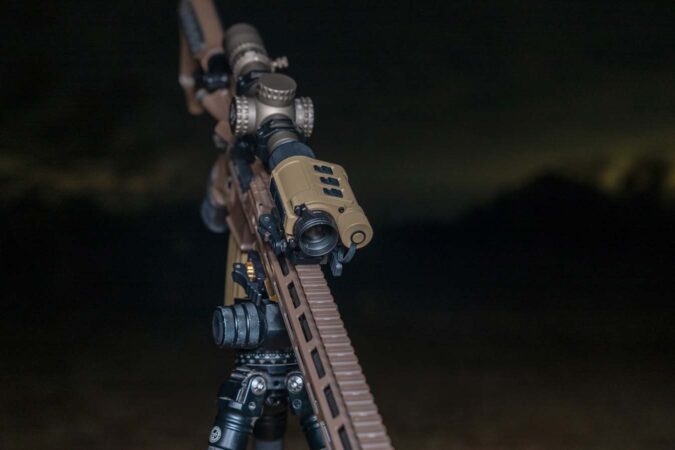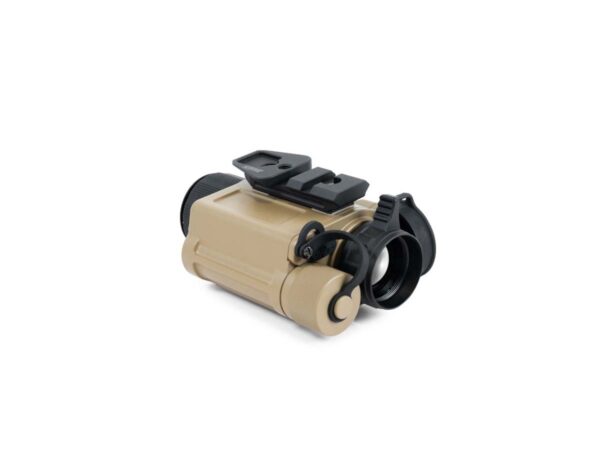In 2022, InfiRay Outdoor quietly offered up a neat little thermal optic, the RH25 from their RICO MICRO series. Turns out, it was just what the market was looking for: a do-it-all thermal that could be used as a clip-on sight, a stand-alone rifle optic, helmet-mounted, or a compact handheld scanner. All at a pretty good price to boot.
In the years that followed, it became apparent that this teeny optic was the one to beat. Or at least mimic. Competitors sprung up offering models in that form-factor, some taking legitimate swings at the little RH25. But its high-quality display and reputation for outperforming in challenging humid settings — along with shrinking prices — kept it high on the list. This year, there’s some pretty impressive newcomers headed to retail shelves, so what’s iRay to do?
Release V2, of course.
The advantage of having a head start, listening to years of customer feedback, refining, debugging, and improving things has led to two new MICRO RH models that released this past fall to kick off hunting season.
Topping the list of refinements, the main goal is improving optical quality. The way to keep ahead of the pack in this business is always going to start with a better picture. That’s kind of the main thing with an optic, isn’t it? If the view sucks, and you can’t resolve targets, it doesn’t matter what gee-whiz bells and whistles something has.
So, the MICRO V2 starts strong with an all-new, absolutely huge display. It’s 80-percent physically larger and has a 97-percent higher resolution than the previous models. Those aren’t insignificant numbers on paper, and they’re even more impressive in real-world use. A 1440×1080 display packs in plenty of pixels to give more information.
And that new 0.71-inch screen delivers a lot more for your eye to look at than the previous model’s 0.39-inch screen did. The sensor Focal Plane Array on the RH25 V2 has a slightly different pixel count than the previous unit (640×480 whereas the original version is a 640×512), but has the same field of view (17.5×13.1). Information it’s delivering via those pixels is coming at you quicker as well: refresh rate has been boosted up from 50Hz to 60Hz to squash lag and jumpiness, making for smoother video.

And a little elegant electrical engineering has been done to reduce latency in the video processing. On top of straight resolution numbers, the signal now travels from the sensor to the display a hair faster as well.
We mentioned the original model’s strong performance in humid environments. This is partially due to something called a “Noise Equivalent Temperature Difference rating.” The NETD of a thermal optic is its ability to separate a target from its surroundings.
Consider it “thermal distinction” or the ability to distinguish between elements with various temperatures. A lower NETD means less pixel noise and cleaner contrast. Put a 98.6 degrees F human in front of an ice-cold rock wall. That’s easy to pick out with most any thermal, right? But put that same person in front of a background that’s also similarly hot — the higher an optic’s NETD number, the more that picture sort of mushes together.
Instead of sharp contrast, you get Arnie smearing himself with cold mud to hide from the Predator. So, what’s the new NETD number? Interestingly, at least a couple other thermal sight manufacturers mention a scale that rates various NETD’s, “25mK (Excellent)
Moving from visual performance to physical improvements, one of the more satisfying additions is just a simple housekeeping feature: the addition of USB-C. Adding this electronics-industry standard instead of the specialized camera cables V1 came with is a relief. The old multiuse data cable that had USB, BNC, and 7-pin connectors was admittedly a bit bulky and archaic. Seven-pin connectors had the benefit of not coming loose easily, but the downsides were being super rare and pricey if you ever lost the included one.

Now, connecting the RH to most computers is as easy as snagging a $8 USB-C cable at Best Buy — in as short or as long a cable as you prefer. Disclosure: Our preproduction test unit had problems connecting to a Mac, but moving to a Windows systems proved no issues. We’re hoping for improvements there, as a lot of video creators are going to want Apple connectivity.
It ships with a couple of next-generation USB-C rechargeable 18650 Nitecore batteries and a dual charger. A single NL1836R battery powers the unit. Each battery has a 3600-mAh capacity and may be fueled up in the charger or by themselves by plugging a USB-C port directly into the battery. A little indicator light shows when it’s fully juiced up and ready to go.
USB-C provides not only connectivity and ability to download the onboard memory to a computer, but also can connect to external power supplies. The old 7-pin Fischer cable wasn’t able to get power from a common 10000-mAh rail, buttstock, or helmet battery for all-night use. Now you can just plug a cellphone battery backup into the USB-C and add many more hours than what the onboard 18650 offers.

That said, iRay didn’t sleep on improving efficiency: battery life went up 18 percent on the new unit. That’s around 6.5 hours compared to the 4-ish hours the previous model offered. Keeping in mind that an increased refresh rate would normally suck power faster, that impressive battery life went up, not down. Still, can’t hurt to have that USB-C power option available, especially to move center of balance/weight off-board.
There’s a little rubber cover for the USB-C port at the front of the unit (which at first seemed an inconvenient place to put it, but after using it a bit, having the port in that location kept cords from getting in the way of fingers when focusing, as well as streamlined things so they’re not protruding off the side). Another rubber cover protects the front germanium lens. This could have sealed tighter when closed and could keep out of the way — and sight picture — better when open. We added some Velcro to keep it pinned back.
Back to connectivity, the RH25 still has the free smartphone app (both Android and IOS worked fine), which lets us up slurp videos and images out of the scope’s onboard storage. You’re able to capture thermal video onto the optic, download the images to a nearby iPhone via Wi-Fi, and be gleefully posting dead swine to your Instabook moments later.

This year, they added recoil-activated video recording with audio, so you can be assured your trophy shot will be captured in all its YouTube-able glory. (That said, be aware the sensor is 640p resolution, so that sweet-looking feed going into your eyeball through the amazing new display isn’t going to look like a 4K Michael Bay production when it gets to your giant TV monitor or desktop computer.)
One of the low-key features we wound up appreciating was the ability to live stream to an iPad or smartphone in real-time. The optic creates its own Wi-Fi network — connect your phone to the optic’s Wi-Fi, open the app, and your phone becomes a surprisingly lag-free viewfinder. And, keeping with the theme of kaizen improvements, even the Wi-Fi connection to the InfiRay Outdoor app gets blessed with a 2x increase in transmission distance.
Let’s talk about ergonomics and ease of use. On the previous model, it would’ve been nice to have a four-way joystick or a fourth button on the controller like some of iRay’s larger scopes. This small scope still has the three inline buttons to work your way down into menus and submenus — which admittedly took a minute or two reading the manual to figure out the menus on the previous model with its mystery-icon-only menus.
But this year, they added actual English word titles hovering above the icons, taking the guesswork and memory aspect out of the equation. This little detail doesn’t sound like much, but the menus are so much easier to drill down and make changes on the fly with just some simplified menus and actual words instead of esoteric icons and button-press-guesses.

On top of that, new to this version is a Bluetooth remote control. A wireless stick can be used remotely or Velcro’d to a rifle stock or rail. The remote has four buttons and a spinning selector wheel for more granular controlling of the optic.
Either way you choose to control your input, the good news is once you’ve got your preferred settings like brightness, reticle types, and such dialed in, you don’t need to mess with it much. Also responding to user requests, the buttons themselves have been redesigned for increased feedback. The buttons seem a little taller, more defined/separated, and give more confident clicky feedback.
The interface has been simplified a bit right from the get-go. The optic remains a “4-in-1” unit in practice, but it’s been streamlined down from four to three general operational/startup modes: “Standalone,” “Clip-On,” and “Helmet.”
“Standalone” mode gives you a straightforward firearm optic all by itself.
Just mount the RH25V2 to a rifle rail, zero one of the seven reticle options of your choice (and four color choices for the reticle), and use it alone as a low power scope.
Referencing that streamlining, there used to be a “handheld” mode, but that’s been folded into the “Standalone” mode. Now, the aiming reticle can just be toggled off for a less-cluttered picture while handheld scanning. When the original RH25 went into handheld mode, the view was magnified 1.3x and switched to a round display.

User feedback seemed to prefer a rectangular display, so as to not clip the field of view. Now the new model stays rectangular in each of the modes, regardless of the unit’s orientation. The picture has the native 1x, and digital 2x and 4x zooming views.
Color palettes have updated to add a few new views that might appear easier on one’s eyes for extended viewing, or to bump up contrast in different conditions. The palette is now: white hot, black hot, red hot, color, violet, crimson, or viridian. There’s a number of crosshair reticles to choose (from “none at all” clearest view, to six other crosshair-type reticles), as well as various color choices for the lines and center aiming point.
“Helmet” mode is made for (duh) mounting to a helmet.
Weight and size are key here, so physical specs were improved to address helmet-mounting customers’ needs. Notably, to make it lighter. There wasn’t much that could be shrunk in the already-small form factor, and the unit’s body shape had to stay the same so that all existing mounting solutions remained compatible. But now a magnesium body replaces Gen 1’s aluminum housing, allowing a 10-percent weight reduction (down from the previous 12.7 to 11.5 ounces). And every gram counts when it’s hanging out from a helmet.
Keep in mind too that there’s a totally new eyepiece on the V2. Its diameter has increased greatly (56 percent larger, up from 17.8mm to a whopping 27.78mm eyepiece). Simply put, this is like your eye looking at a larger, higher-resolution TV. The bigger screen is more forgiving of helmet wobbles or mount movement when running around at night. This screen provides increased eye relief to smooth out helmet movements in the fore-and-aft directions as well.

“Clip-On” mode allows the user to plunk the thermal down on the rail in front of a dayscope.
You view the screen of the thermal through your dayscope, using its existing zero to aim at what you see on the display. The advantage here is that you can keep one rifle set up for both day and night use without swapping scopes around.
It should be noted that previously only the more expensive 640 resolution RH25 had this ability of clip-on mode. It wasn’t offered in the less-expensive 384 resolution RL25. A lot of people ponied up for the 640 version not just for the higher resolution, but to get the additional capabilities. But now both the RH25V2 and RL25V2 will have the clip-on function available. This decision was made because the upgraded display and eyepiece combo gives enough of a performance bump to allow even the lower-resolution sensor to perform well enough to be used for front-of-scope magnification.
Finally, a global improvement to the system is that you can now create independent setting parameters for each of these three operation modes.
Both models ship in a durable hard case. Inside is everything needed to get you set up and shooting (thermal zeroing targets, cables, batteries, charger, etc.). The new units continue to offer the solid iRayUSA warranty (iRayUSA’s Texas facility will repair or replace warranty claims in five days, for five years).
Read the full article here





